After a couple of days during which I visited parts of Germany and France mostly by a rented car, I returned the vehicle where I first took it and that was at the airport officially called EuroAirport Basel-Mulhouse-Freiburg because it is situated close to a tripartite border between Switzerland, France and Germany, although it is physically located on the territory of France.
Then, using a combination of a bus and a train, I transferred to Milhouse. I had already rented a room within a flat there, but the most important thing about it was that the flat was quite close to the railway station.
I had received clear instructions from the owner and as I was going up the stairs within the building, I came across a young couple. The young man asked me in English if I needed any help, thinking of my relatively big bag, but I thanked him and said I was all right and was dragging myself only because I had rushed the whole day while doing my sightseeing. He said he was glad to come across somebody who spoke English. I asked them where they were from and they said they were from Serbia. Then I told them in Serbian that we can speak our language as well. This was all very cute and the next couple of days we often crossed paths within the flat, i.e., in the kitchen that is shared with the guests staying in the rented rooms. I was particularly glad that our young people were so well mannered and kind, and that they were ready to offer to help. I also hope that, when we first met each other, I did not seem too exhausted and too old (which I am, especially compared to them). Their names are Tanja and Stojan.
Right after leaving my things in the room, I dashed out while it was still early in the evening to grab a bite. I did not go far and the dinner was very good.
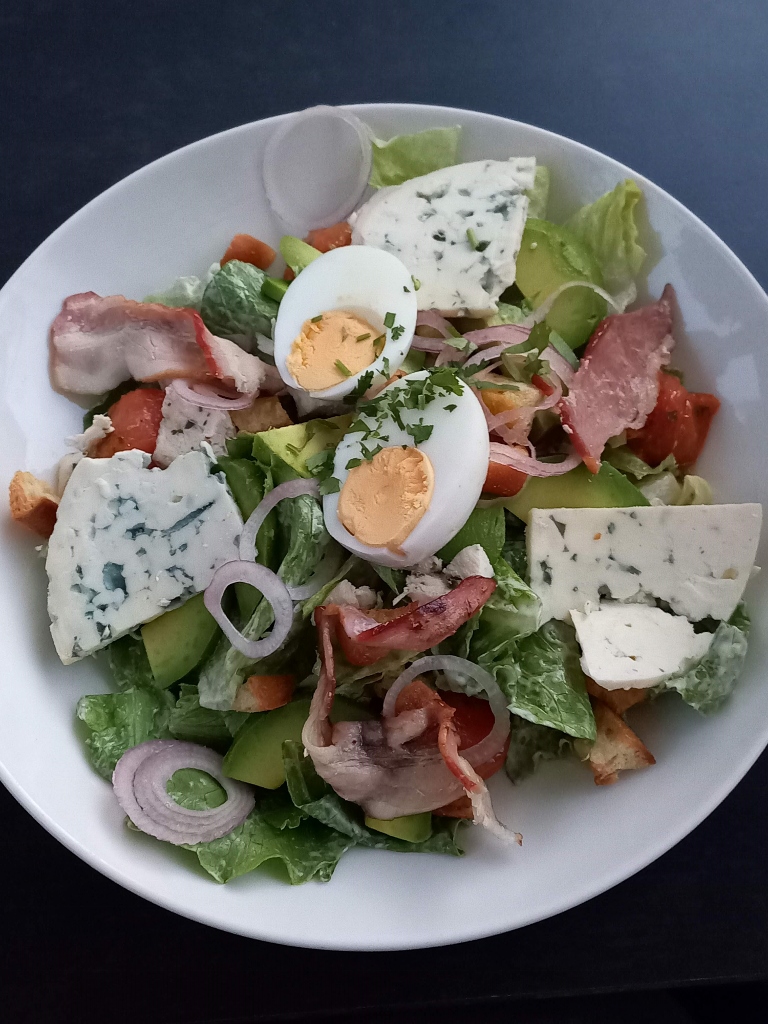 Dinner in Milhouse
Dinner in Milhouse
Since I no longer had a rented car, over the next several days my moving around and sightseeing of various places closer and farther away from Milhouse came down to the use of trains. I had a clear idea where I wanted to go, but I did not care about the order of the visits. But, since the weather was unsettled these days, I actually used weather forecast as a helping tool in making the decision to the effect. And so, it turned out that the following day I should go to Switzerland.
I have already said that the EuroAirport serves three cities in three different countries. Moreover, the airport is most often referred to as Basel airport, probably because it is physically closest to Basel. There is also a special exit at the airport that leads straight to Switzerland. But, my decision was to stay in Milhouse and to go for all the sightseeing using the public transportation from there. Basel is some 40 km away from Milhouse and there are regular trains between these two cities that take around half an hour.
While I was originally planning this trip, I certainly wanted to revisit Basel. I was there many years ago when I travelled around Europe using an Inter-Rail pass and on that occasion I reached Basel directly from Freiburg which I visited in detail this time while I still used the car. At the time of my first visit to Basel I used to leave my backpack at the railway stations’ cloakroom, while I did the sightseeing. I don’t know what the prices for such service are today, but back in the day it was very cheap and it was certainly much easier than if I tried to visit a place carrying a big backpack all the time.
I had no problems or uncertainties of the kind now and I wanted to visit Basel a little more thoroughly. In the meantime, I had been in Basel once again as well, but very briefly and superficially, so I wanted to rectify it this time.
But, as it turned out, I also had to go to Bern on an “errand” there. Namely, under normal circumstances I function with Serbian dinars and euros, but already years ago I developed a habit of buying a small quantity of some other currencies “just in case” since I always hope that one of my next trips can be to some other country and not only those that use euros. My foreign currency credit card is linked to a euro account and I don’t see a reason why I would undergo a double exchange if I can help it (my income is in dinars and I have to buy euros).
And so I thought I was very smart. But, before this trip I realised that some of my Swiss banknotes had been changed, i.e., they were no longer in circulation. I could probably exchange them in Belgrade, but against a commission.
However, since I was going to Switzerland, why not change the money there? As it turned out, this cannot be done just about anywhere. Moreover, I could not find any place in Basel where I would be able to do that, but it was possible to do in Bern that was only an hour’s train ride away from Basel. What a wonderful excuse to go to Bern as well!
I have to say that I was also in Bern before, but quite some time ago. I knew that it was a beautiful place, especially the old part of Bern that is in UNESCO’s World Heritage List. In other words, quite a good reason to go there, while at the same time solving this banknote business.
That’s why I bought in Milhouse a return ticket to Bern, with a change of trains in Basel. The plan was to switch to the train heading for Bern as soon as I reach Basel, but to make a break for the sightseeing of Basel on my way back.
And that’s what I did.
While travelling through Switzerland, the train passed a little by some pretty green landscapes, then by some small human settlements, then by industrial plants and then also through tunnels. What I want to say that there were not too many inspirational sights to take photos of, although I did try carefully to find a good place to sit in order not to be bothered by the position of the Sun.
As for Bern, it is the capital of Switzerland, but this needs to be explained. Switzerland is a confederation consisting of 26 cantons. In 1848, the Federal Assembly made a decision that the seat of the government should be in Bern, but that various other federal institutions should be located in other cities around the country. The 1999 Constitution still did not deal with formalising the issue of the Federal City (name for the capital), so practically by law, de jure, Switzerland does not actually have a capital. But, in the practical and factual sense, de facto, this function is played by Bern that is often referred to as the Federal City.
The good thing about reaching Bern by train is that the railway station is situated in the direct proximity of the historical centre of the city. This is very important because the Old Town of Bern is on the UNESCO’s World Heritage List, which means that it is certainly worth the visit.
The city was founded in the 12th century on a hill around which flows the Aare River. The buildings that can be seen in the Old Town date back to different periods, but most of them were built in the 18th century. It is also possible to see here arcades from the 15th century and public drinking fountains from the 16th century. What makes Bern very important is its urban planning and it is particularly significant that regardless of its development and continuous renovation of the buildings, the original urban planning concept has not been jeopardised in any way.
So, as soon as you leave the railway station using the main entrance/exit, you come across an interesting church, while the “main street” starts towards the left (as seen from the angle of the photo below) right from its front facade. This route formally consists of a couple of streets, but these are rather different segments of the general direction that have different names.
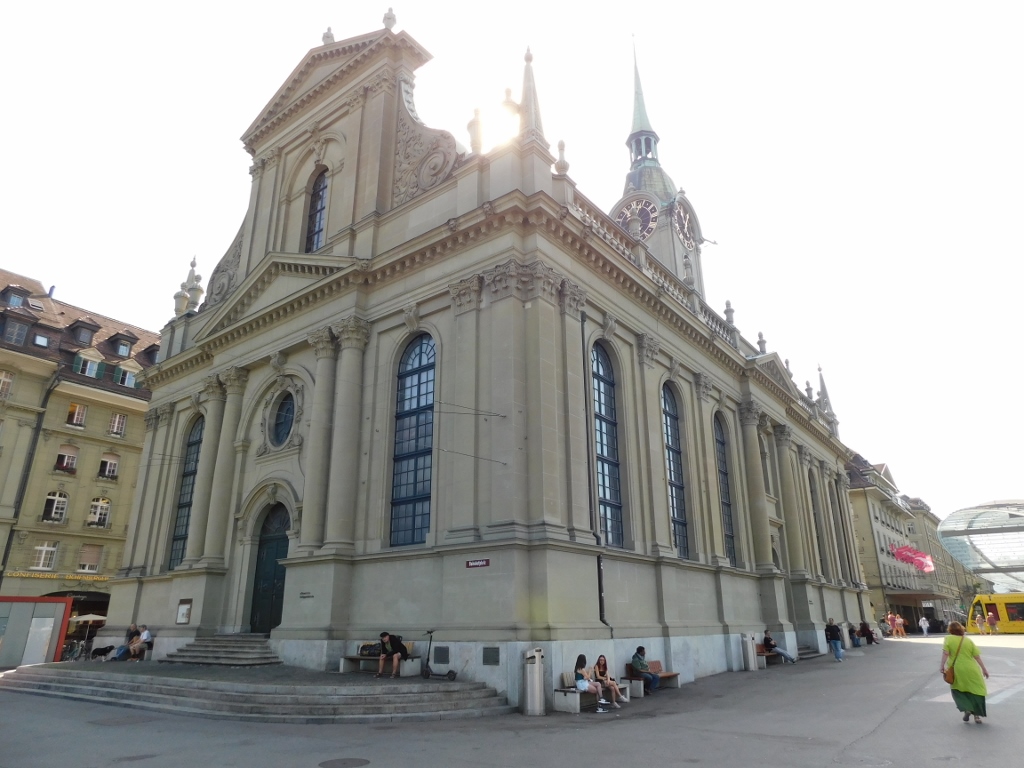 Heiliggeistkirche church
Heiliggeistkirche church
This first church that can be seen right by the railway station is called Heiliggeistkirche meaning the Church of the Holy Ghost and it is one of the biggest Swiss protestant churches. The church was consecrated in 1729 and was built in the place where previously there used to be two churches (one from the 13th century and the other from the 15th century), while some archaeological finds from the site suggest that there also used to be a Roman temple.
But, apart from being able to look at it from the outside, I could not enter since the church had its “working hours,” which meant that it was closed on Mondays. Oh, yes, this was a Monday.
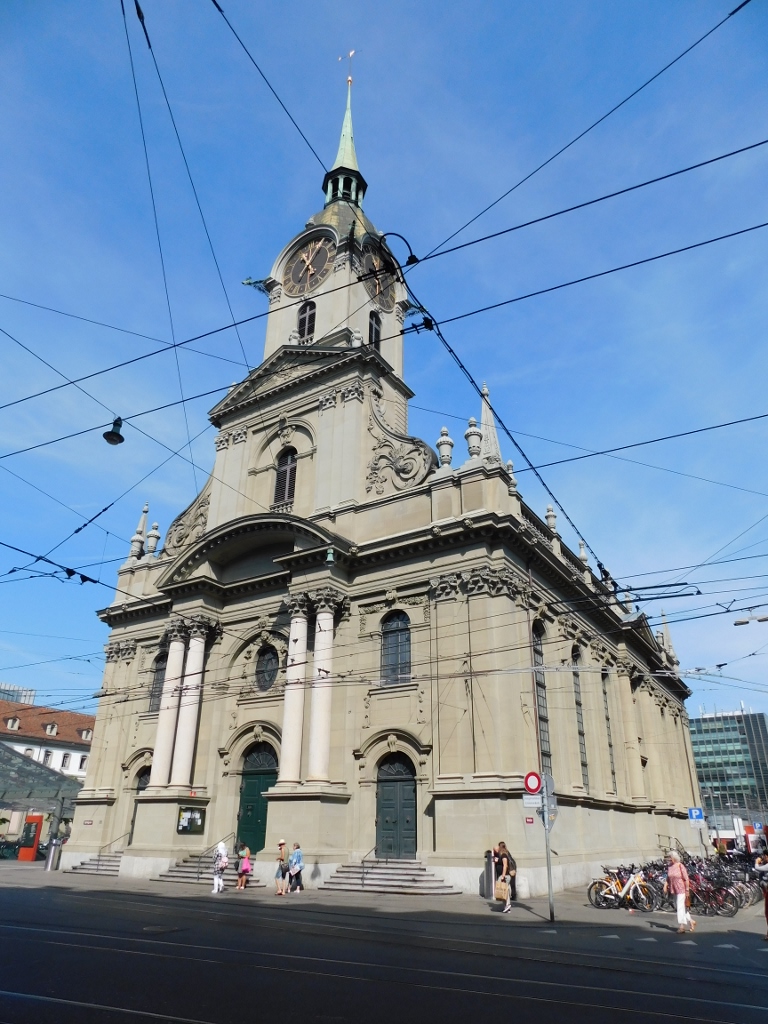 Heiliggeistkirche church, the front facade
Heiliggeistkirche church, the front facade
So, the street called Spitalgasse goes from this church in the direction of the east and a little farther away the visitor can notice one of the landmarks which is the Käfigturm.
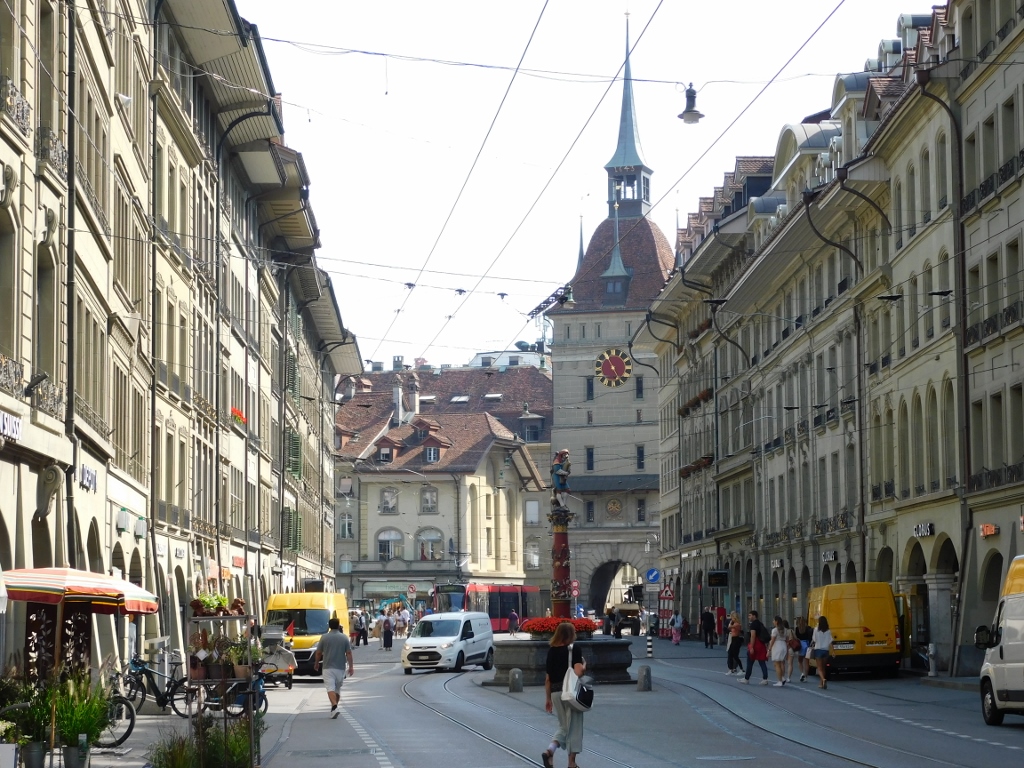 Spitalgasse and Käfigturm
Spitalgasse and Käfigturm
In the middle of the street used by cars and trams and city buses, you can see one of the numerous drinking fountains in Bern. This one is from the 16th century and on its top you can see the figure of a bagpiper.
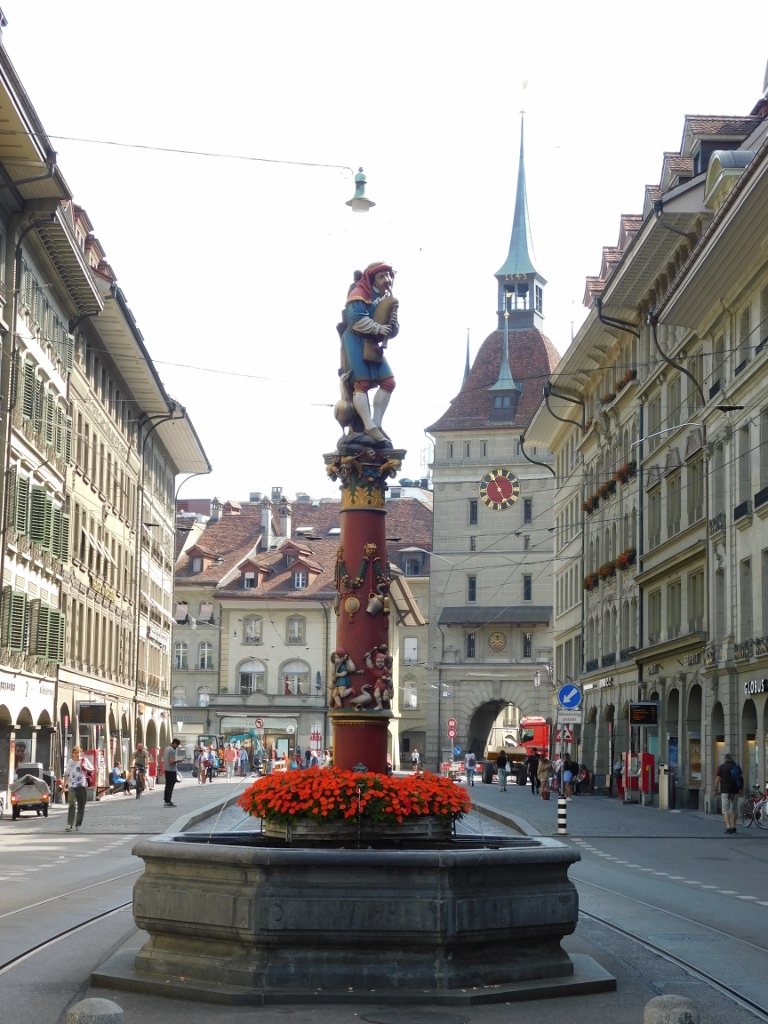 Pfeiferbrunnen
Pfeiferbrunnen
As for the Käfigturm, the original tower in this place was built in 1256 and it served as a tower adjacent to one of the city gates. That tower was brought down in 1640, but soon enough it was completely reconstructed.
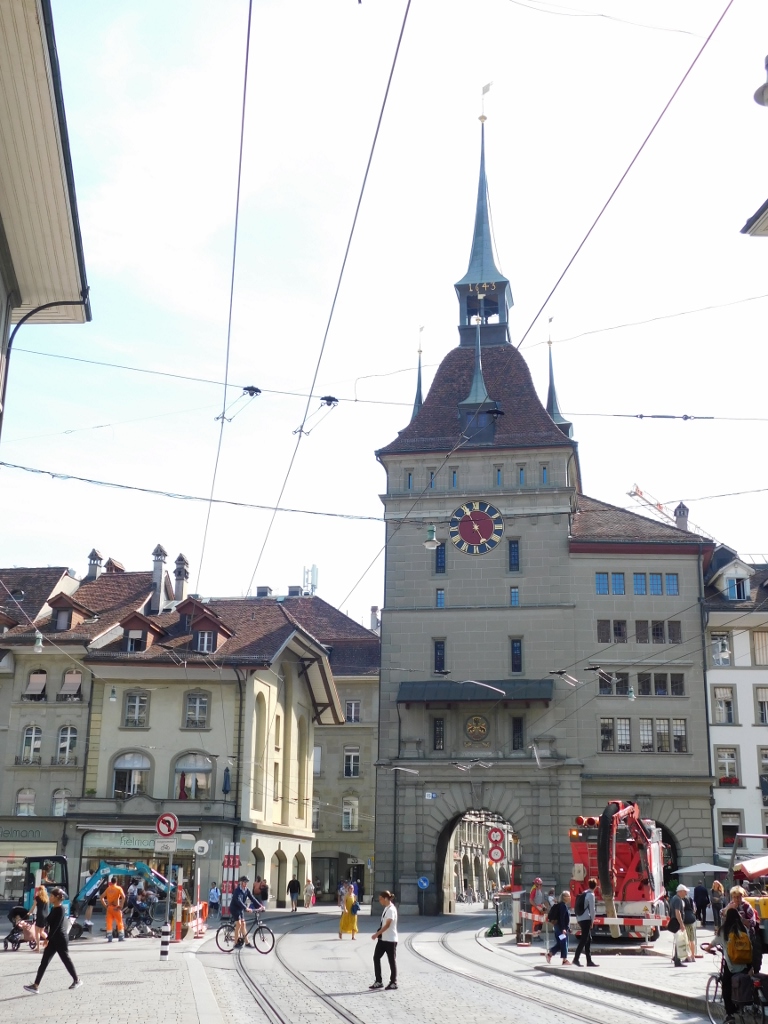 Käfigturm
Käfigturm
By the way, medieval Bern had a couple of expansions and on these occasions the city walls and high towers were also built with gates that led into the city. One of the towers was removed in the second half of the 19th century, but two have remained. The Käfigturm is one of them.
By the Käfigturm, on both sides of the street, there is a spacious square called the Bärenplatz, meaning the Bear Plaza. There is a special connection between Bern and bears, but I will say about this a little more later on. For now, I would like to mention that the square was first mentioned under this name around the middle of the 19th century and when I came here at the end of August 2022, I came across a nice green market and I found it interesting to compare the prices of different fruits and vegetables. Everything was significantly more expensive in Switzerland than in Serbia.
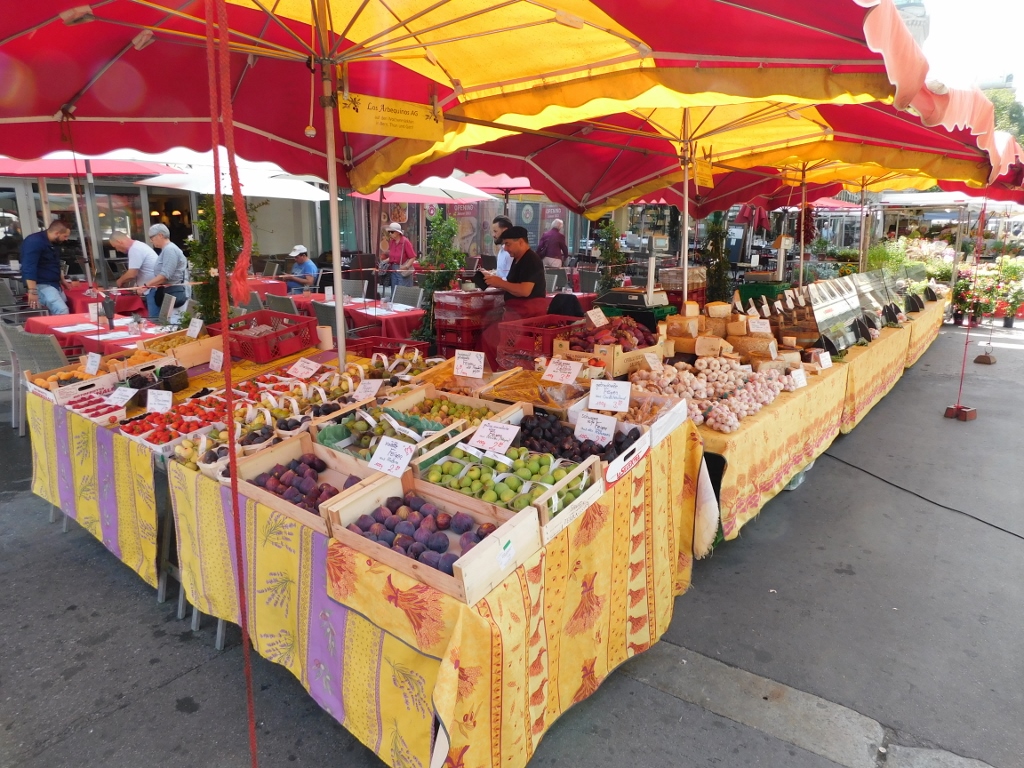 The Bärenplatz green market
The Bärenplatz green market
Another drinking fountain may be seen in the square, but it does not belong to the group of the 16th-century historic fountains. This one is simply called the Bärenplatz fountain – Bärenplatzbrunnen.
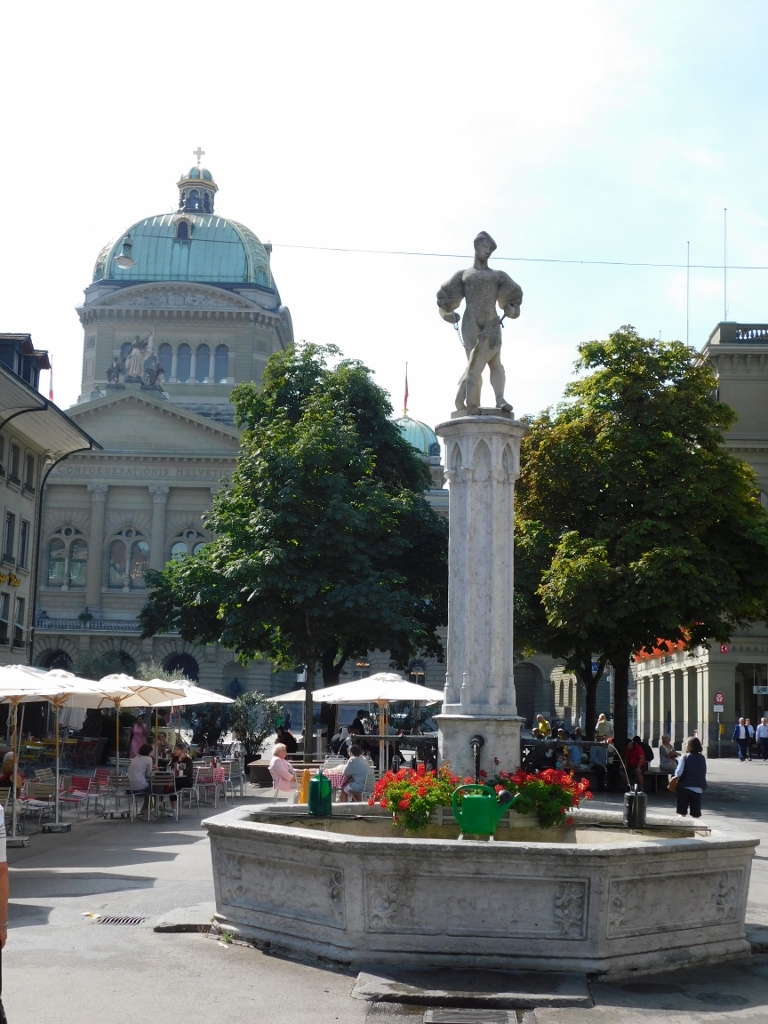 Bärenplatz fountain
Bärenplatz fountain
In the photo above, a little further in the back, one can see a part of the Federal Assembly and this was where I headed to.
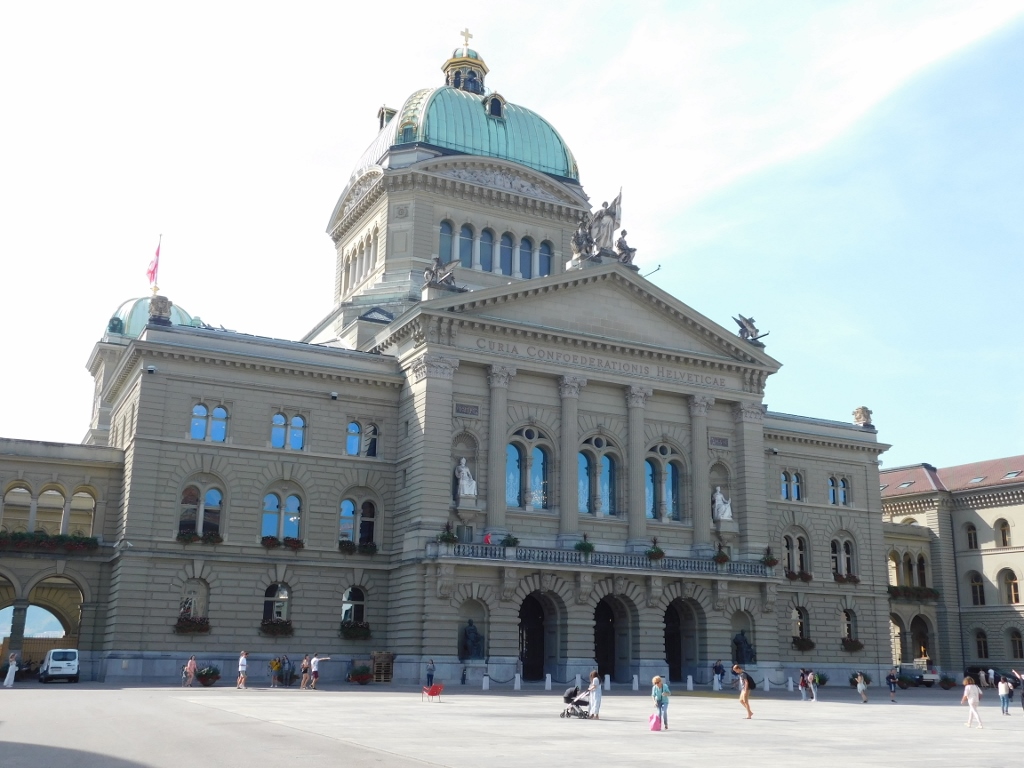 Federal Assembly
Federal Assembly
On the front facade of the building, just below the pediment, you can see inscription Curia Confoederationis Helveticae, which is the Latin name for the Swiss Federal Assembly. I have always been puzzled by this Helvetia thing and Switzerland, so now I read a little about it.
Helvetia is the name of an ancient region that comprised the territory of present-day Switzerland and this name has been used as a personification of the whole country, But, since there are as many as four official languages in Switzerland – German, French, Italian and Romansh – for practical reason it is not always convenient to write, for instance, the name of the confederation in all four languages. That’s why there is a custom that when the use of the official languages is too complicated, the name of the country is written in Latin.
In front of the Assembly building there is a spacious square that is simply called the Federal Square (Bundesplatz).
 Bundesplatz
Bundesplatz
What was very important for me on this occasion was the fact that on the same square where the Assembly was, there was also the Swiss National Bank building. In the photo above, this is the building on the right-hand side, in the shadow.
As I’ve said, I was supposed to change some banknotes and I can report that I did this very quickly and efficiently with broad smiles on the faces of all individuals involved in the transaction. So, my relaxed sightseeing of Bern could continue.
That’s why I returned to the central street, but “after” the Käfigturm, when seen from the direction of the railway station. In that section, the street is called Marktgasse and that name is used from the Bärenplatz on.
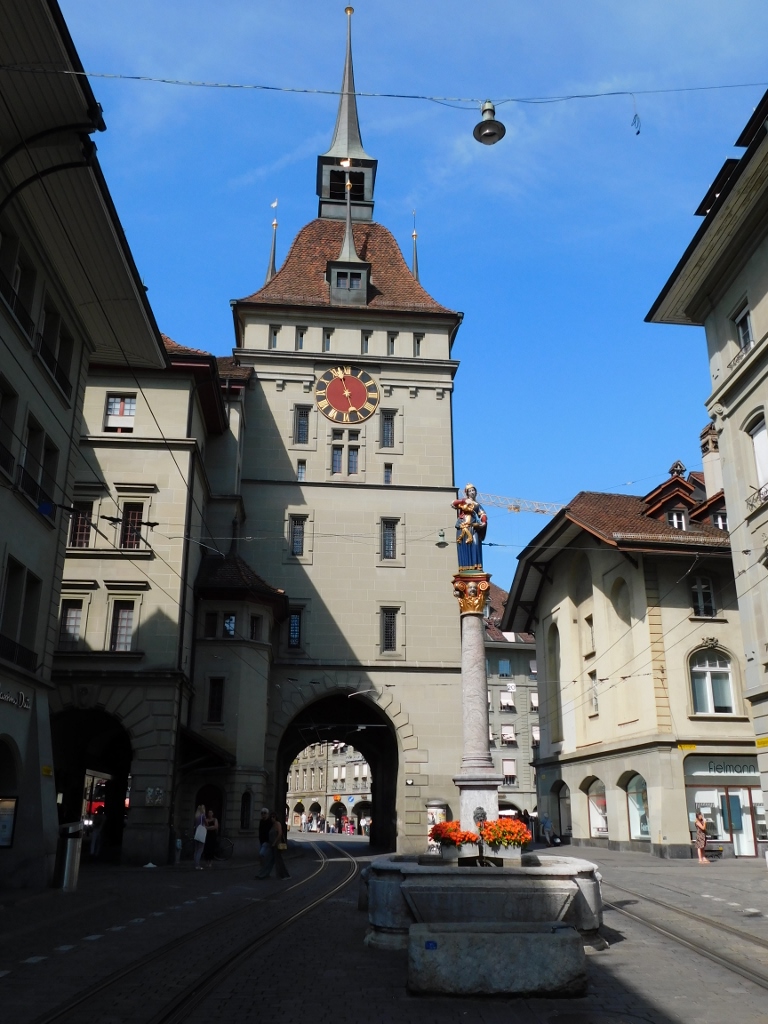 Käfigturm as seen from Marktgasse street
Käfigturm as seen from Marktgasse street
In the photo above, you can see yet another of the historic fountains. This one is called Anna Seiler Fountain (Anna-Seiler-Brunnen) after a woman who founded a hospital in her house in 1354.
And when you look down the street in the opposite direction, a little farther away you can see one more tower that was built along with the city walls. This one is called the Zytglogge and it was built at the beginning of the 13th century.
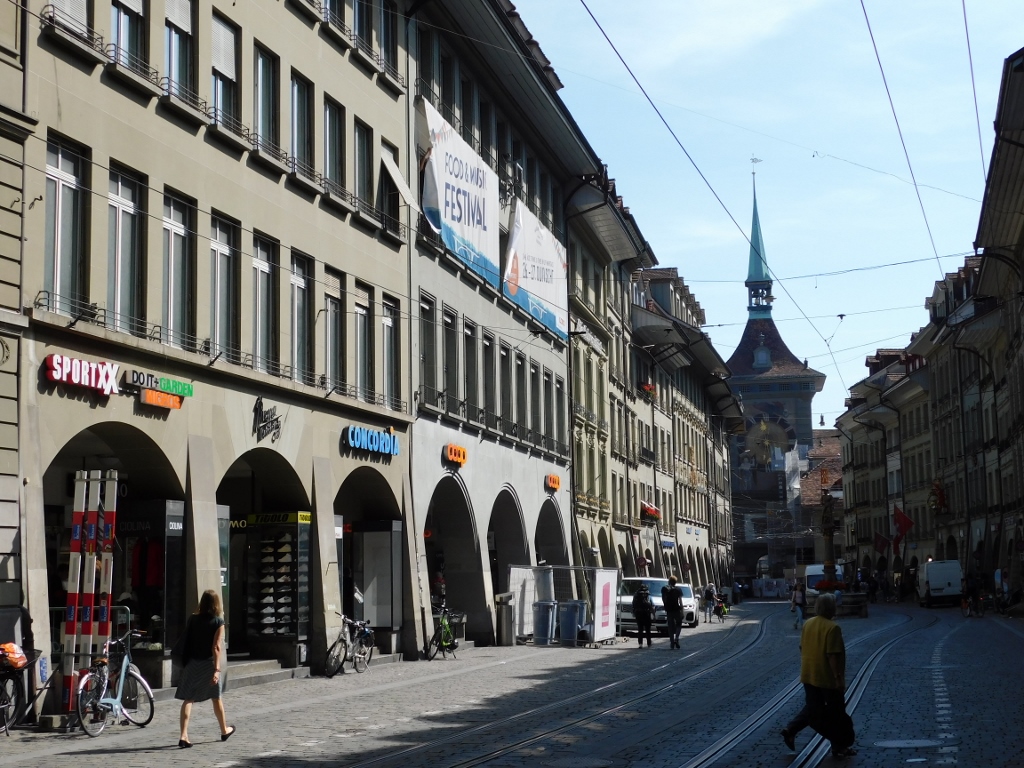 Marktgasse street and the Zytglogge a little farther away
Marktgasse street and the Zytglogge a little farther away
There is yet another drinking fountain from the 16th century in this part of the street, concretely the Schützenbrunnen and from the following photo one can conclude that these drinking fountains in Bern still function and that their water is quite safe to be drunk and is certainly free.
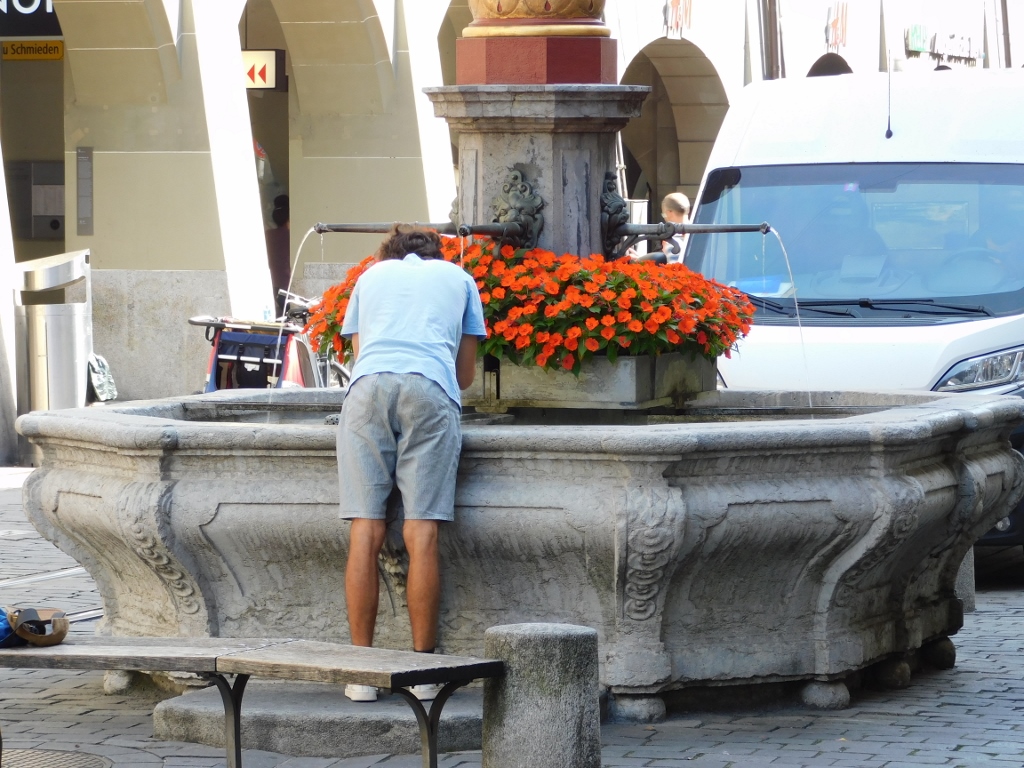 Man gets refreshed at the Schützenbrunnen drinking fountain in Marktgasse street
Man gets refreshed at the Schützenbrunnen drinking fountain in Marktgasse street
By the Zytglogge tower, the main street is cut by a rather wide street that leads to one of the bridges over the Aare river, while from this point the main street changes its name once again and is called Kramgasse.
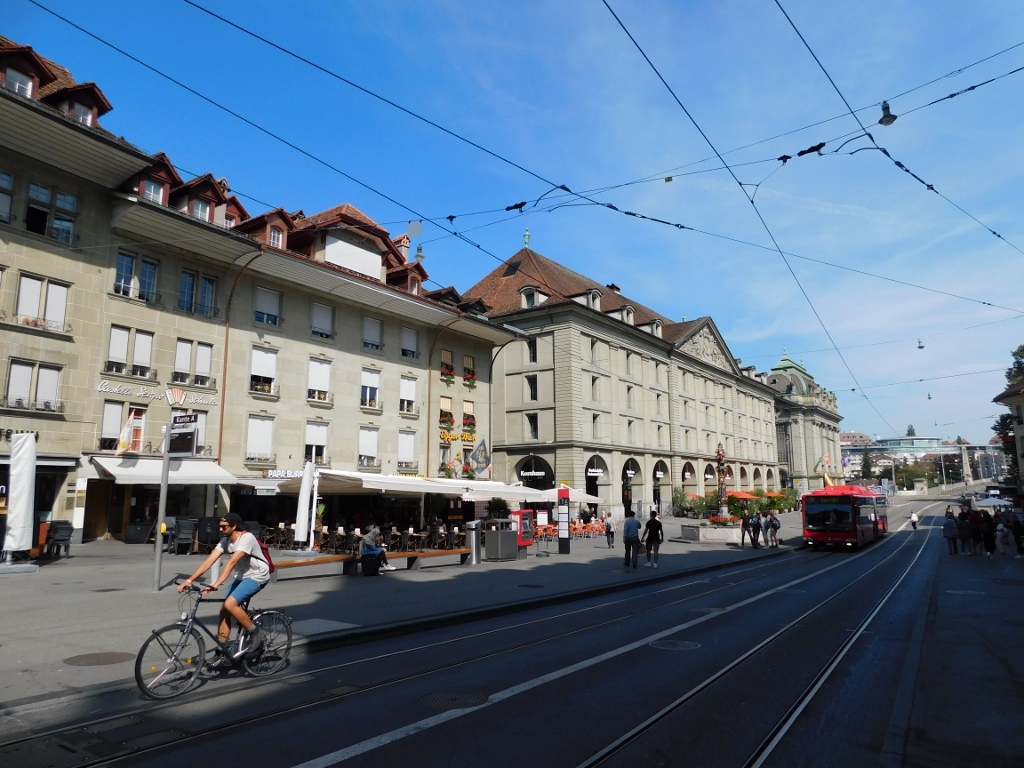 Street that leads to a bridge from the Zytglogge tower
Street that leads to a bridge from the Zytglogge tower
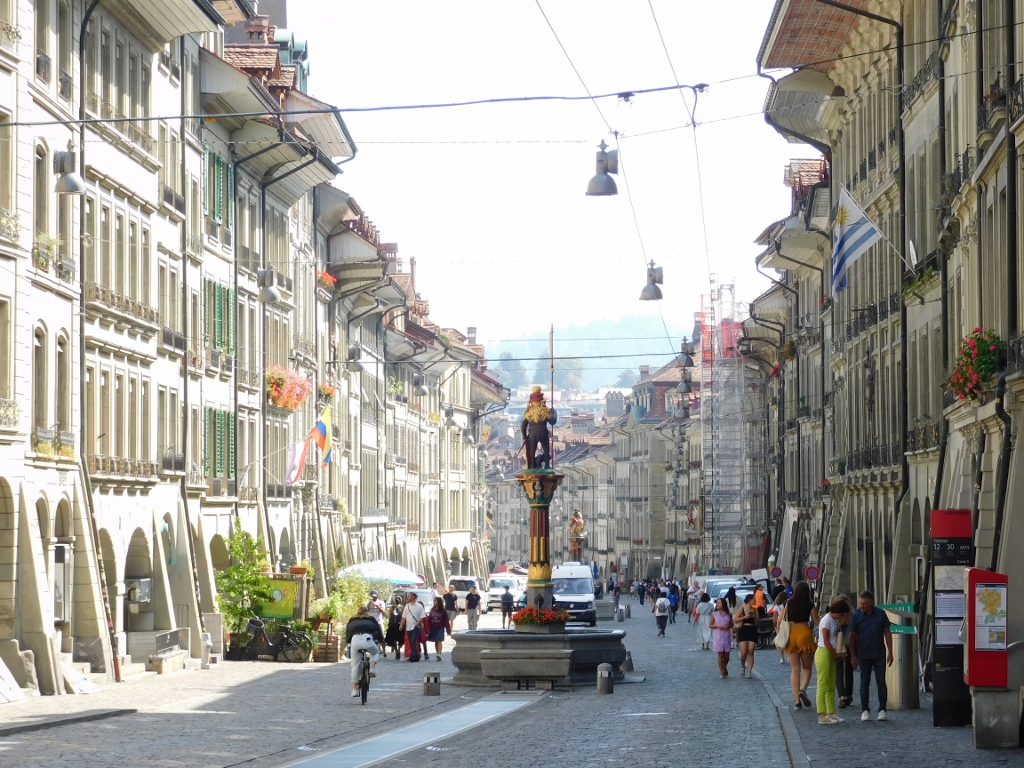 Kramgasse street
Kramgasse street
As it can be seen in the previous photo, here in the middle of Kramgasse there is also a drinking fountain. Again, this is a historic fountain from the 16th century and this one is called the Zähringerbrunnen. Perhaps this is a good moment to tell the story about the link between Bern and bears.
Namely, this fountain is dedicated to the founder of Bern, Berthold von Zähringer. The statue on the top of the fountain is in the shape of a bear in armour. According to the legend, Berthold decided to found a city on this hill above the Aare river, but he made a vow that the city will have a link with the first animal killed in this place. As it turned out, this was a bear (Bär in German) and thus the city itself got its appropriate name, while the silhouette of a bear can also be seen on the city’s flag.
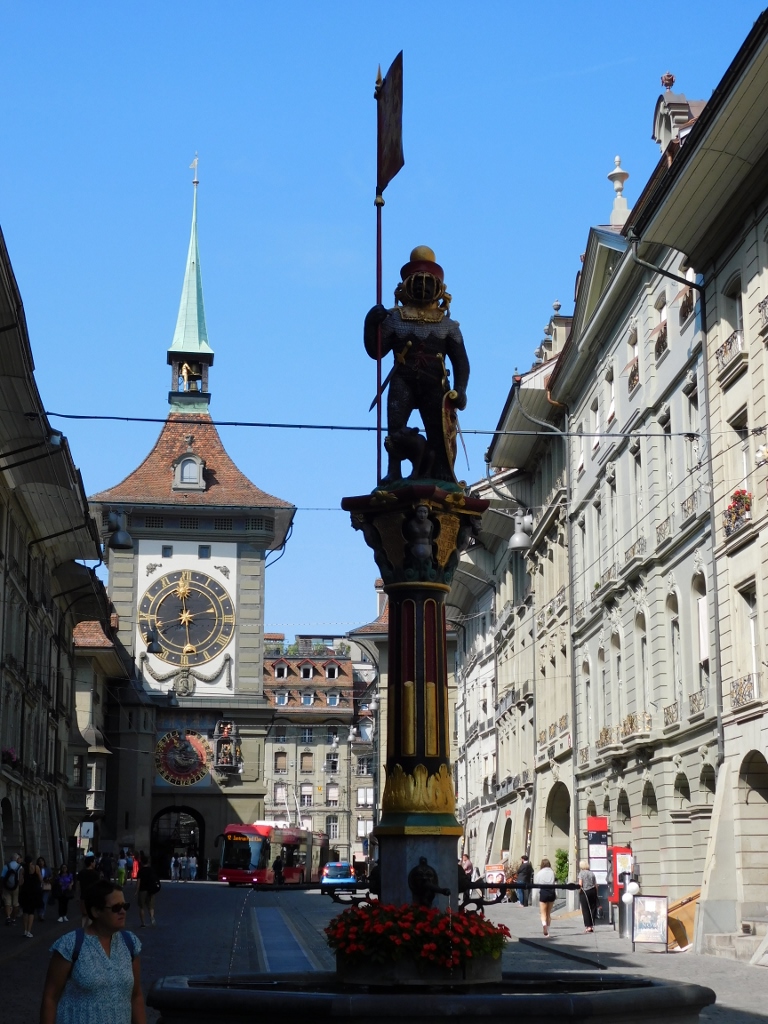 Zähringerbrunnen with the Zytglogge in the background
Zähringerbrunnen with the Zytglogge in the background
As it can be concluded from the photograph, I passed by the Zytglogge tower relatively at ease and moved on, since I planned to pay more attention to the tower on my way back to the railway station.
For now, I first noted a building at Kramgasse no. 49. There is a museum here called “Einstein’s house” (Einsteinhaus) and this is because of the fact that from 1903 to 1905 Albert Einstein lived here with his family – his wife Mileva Marić and his son Hans Albert.
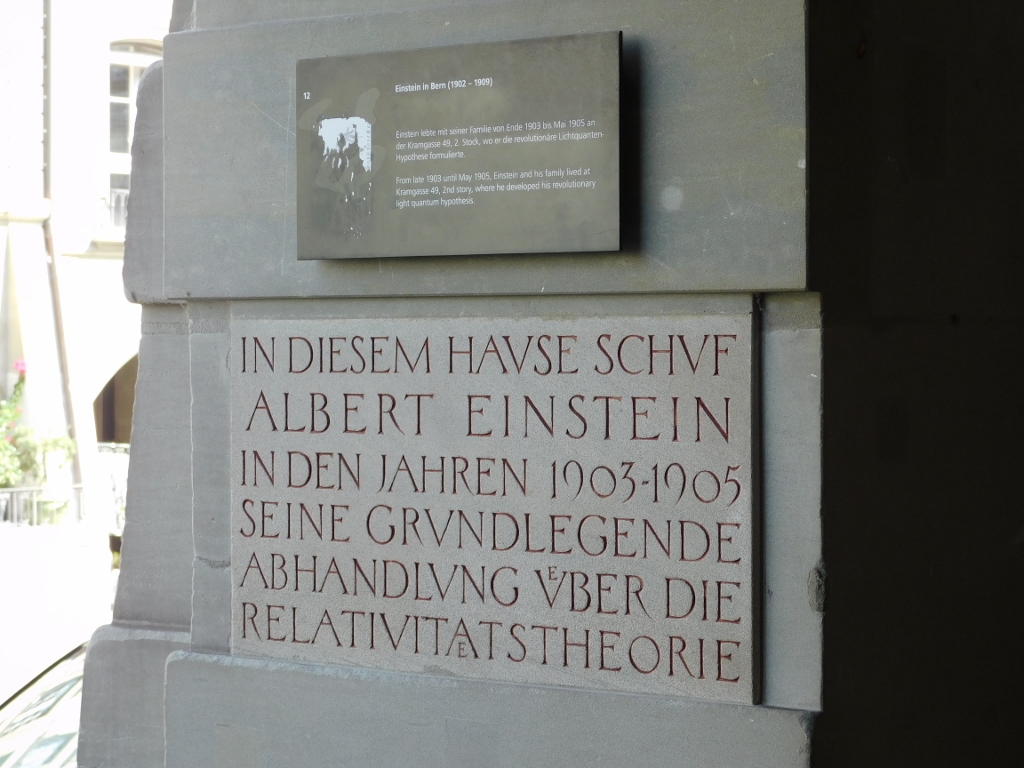 Plaque marking the entrance into the “Einstein’s house” Museum
Plaque marking the entrance into the “Einstein’s house” Museum
Although I am aware of the fact that many people love everything to do with celebrities, since all is relative, I am not very much interested in Albert Einstein and having a detailed view at his life. Yes, I know his theory of relativity, just as I know that his first wife was a Serb. So, I just wanted to see where they used to live, but I was not interested in the museum itself.
That’s why I just continued with my stroll to the nearby Münsterplatz, that is, a square in front of the cathedral in Bern. There I came across yet another 16th-century fountain. This one is called the Moses Fountain (Mosesbrunnen).
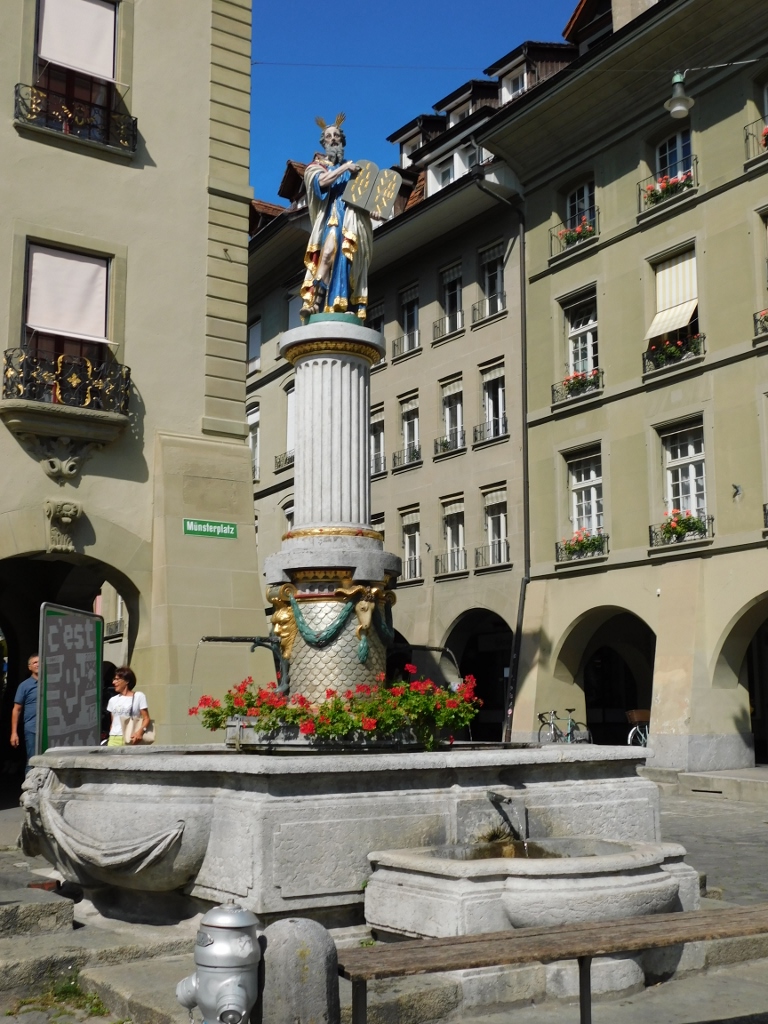 Mosesbrunnen
Mosesbrunnen
The Münsterplatz is a part of the historic segment of the Old City of Bern and it was formed already when the city was first founded, i.e., in 1191, There are various big buildings around the square, but I particularly liked the chairs scattered across the square, but not fixed to the ground, and earmarked for the visitors to have a rest while sitting on them.
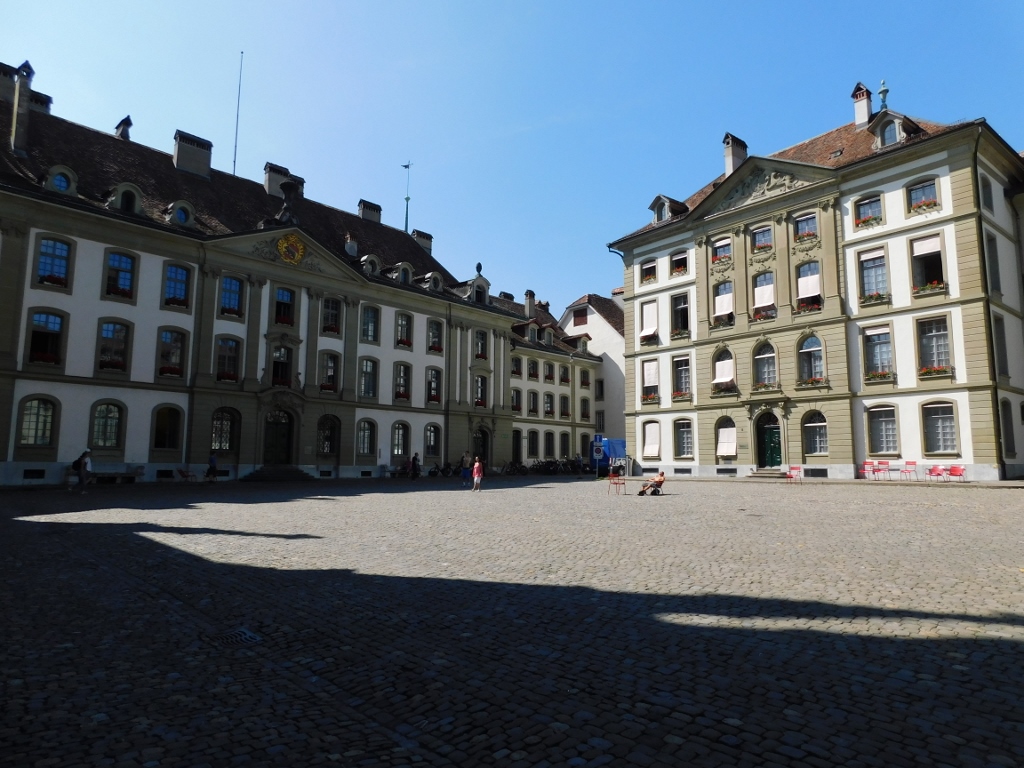 Münsterplatz
Münsterplatz
On the east side of the square there is the Cathedral of Bern (Berner Münster).
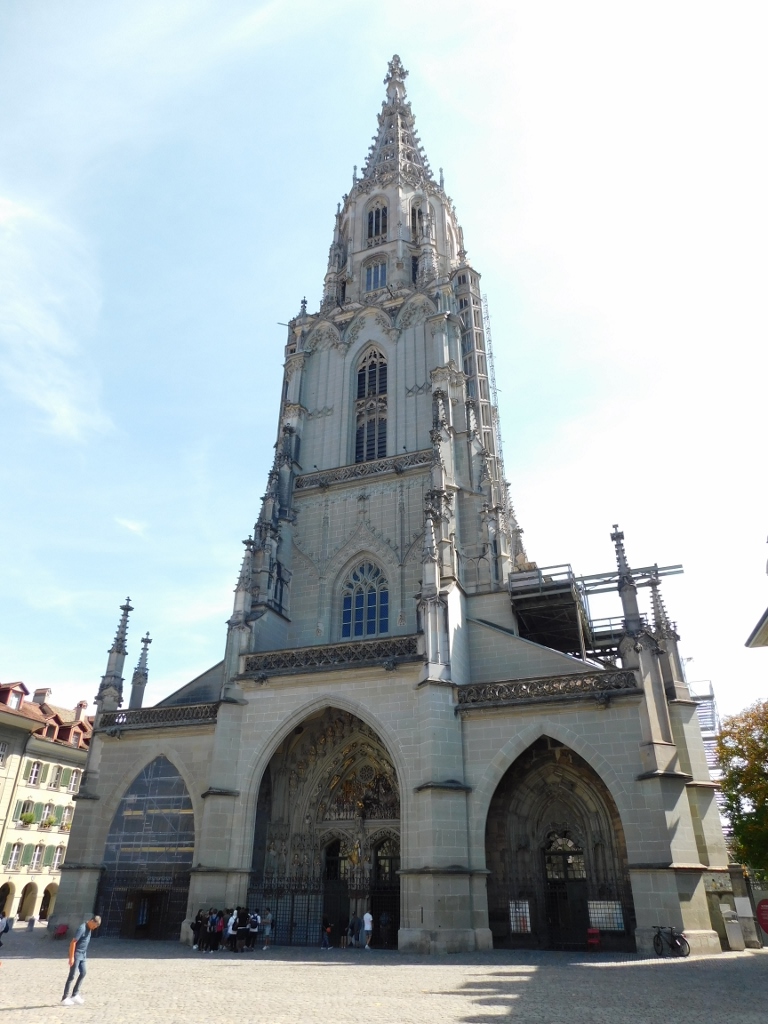 Cathedral of Bern
Cathedral of Bern
The construction of the cathedral started in 1421, while the tower was finished as late as in 1893. The tower is 100.60 m high and this makes the cathedral the highest in Switzerland. On its west side, the cathedral has three doorways and I have read somewhere that the middle one is particularly important because of the decoration in the shape of statues that depict the Last Judgment, so I took a photo of this.
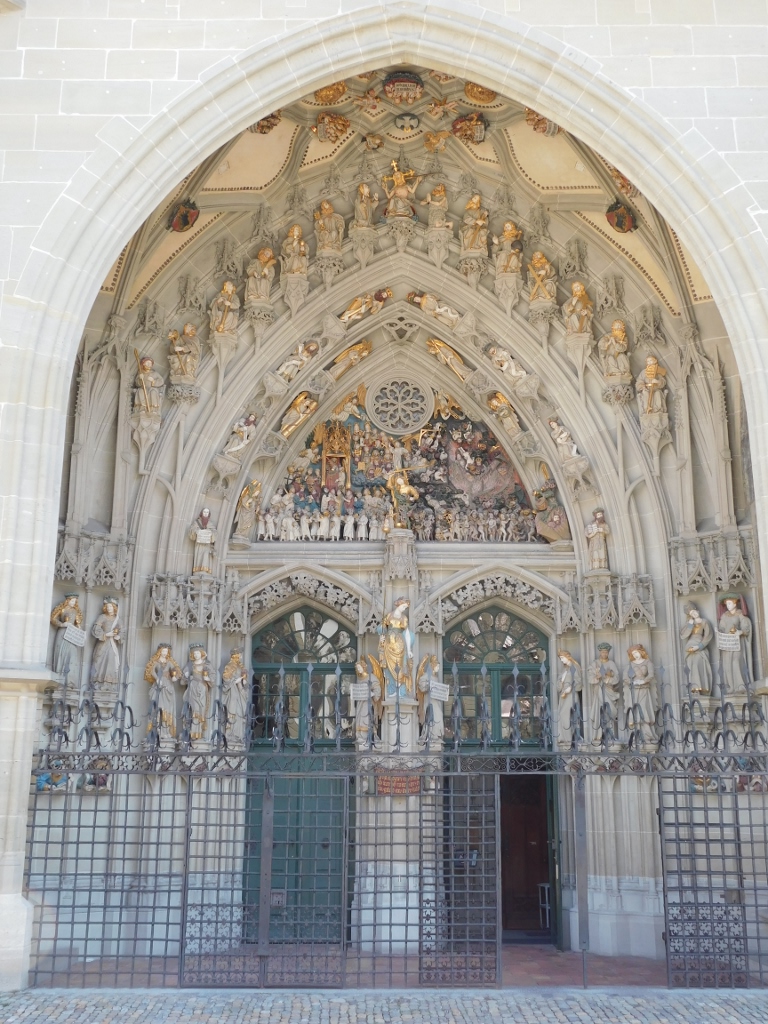 Central doorway to the Cathedral of Bern
Central doorway to the Cathedral of Bern
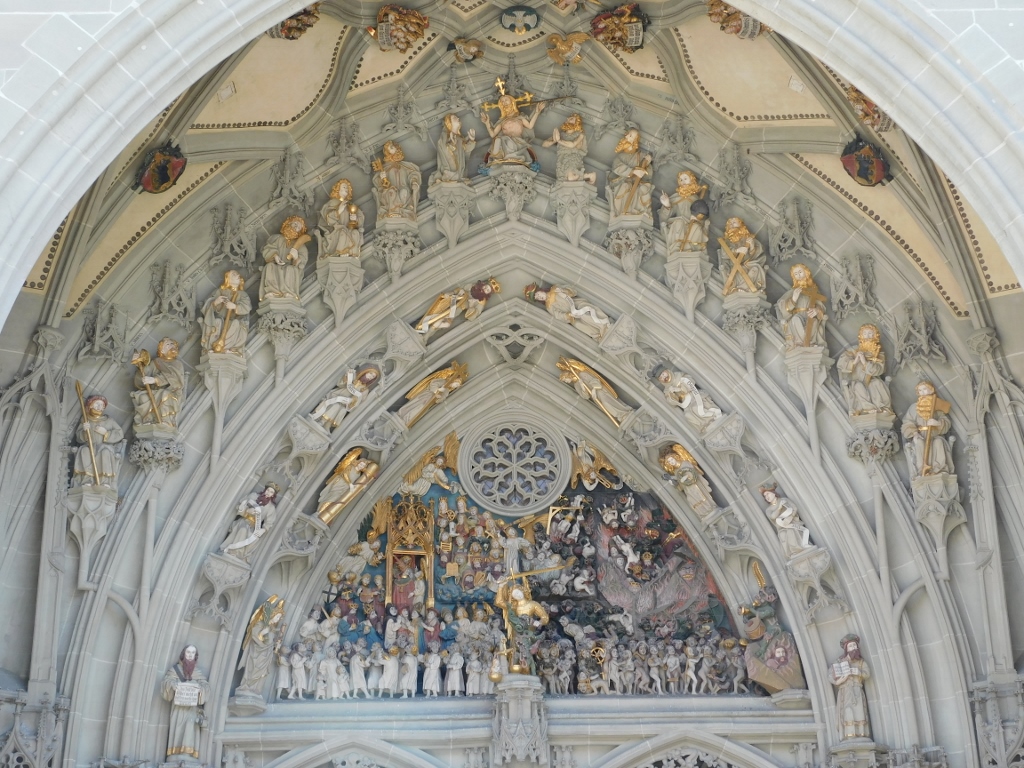 Central doorway to the Cathedral of Bern, a detail
Central doorway to the Cathedral of Bern, a detail
Then I entered the cathedral and walked around a little. Here are a couple of photos:
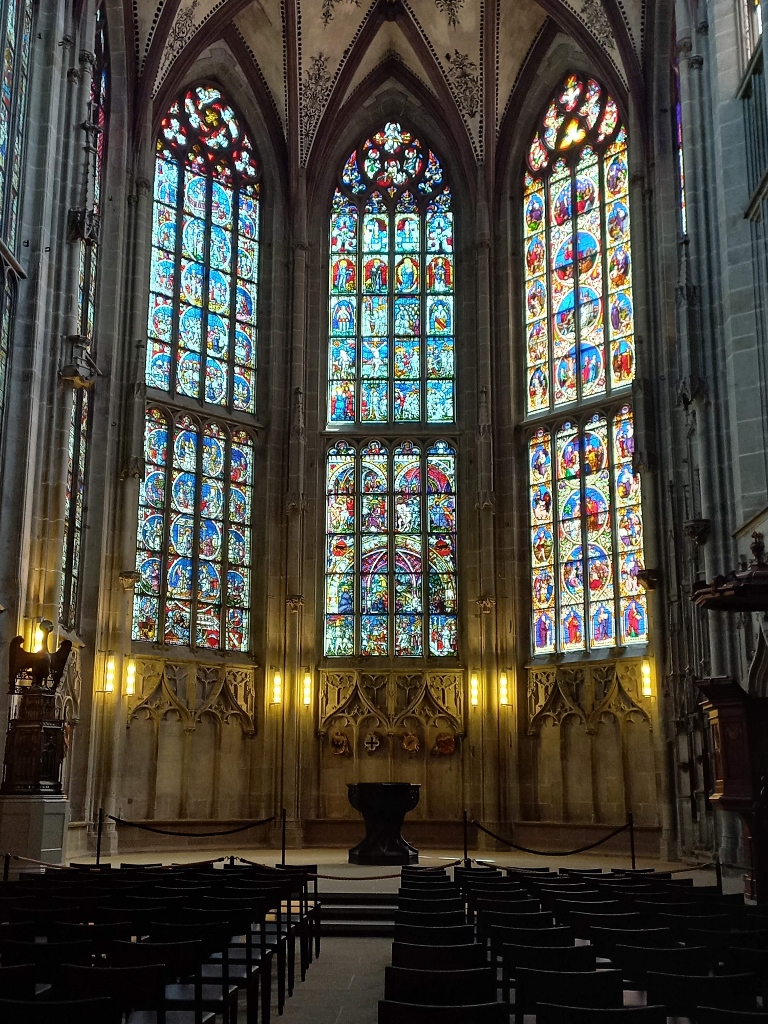 Cathedral of Bern, a detail
Cathedral of Bern, a detail
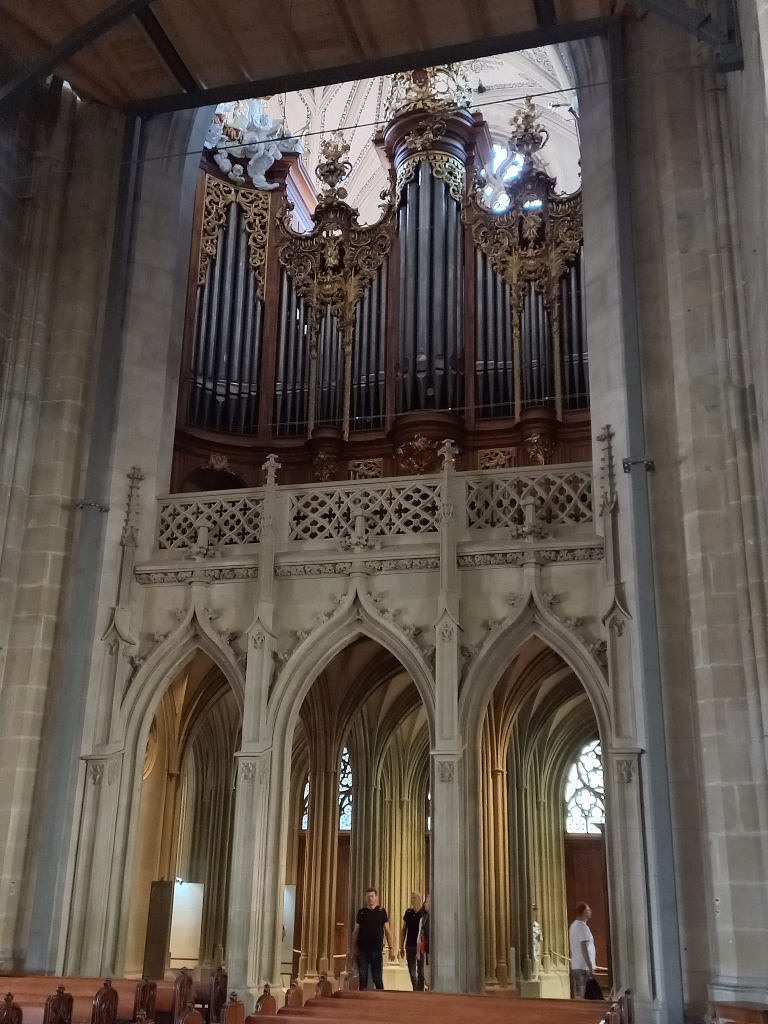 Cathedral of Bern, a detail
Cathedral of Bern, a detail
When I exited from the cathedral, I noticed a woman that was standing by one of the neighbouring buildings, as if she was on a break. I asked her if the water at the fountains was potable and with great delight on her part she said it was and it was in fact very good. A little later, at one of these fountains I refilled my water bottle.
For now I walked to a park that is situated alongside the south wall of the cathedral and that is called the Münsterplattform or the Minster Terrace.
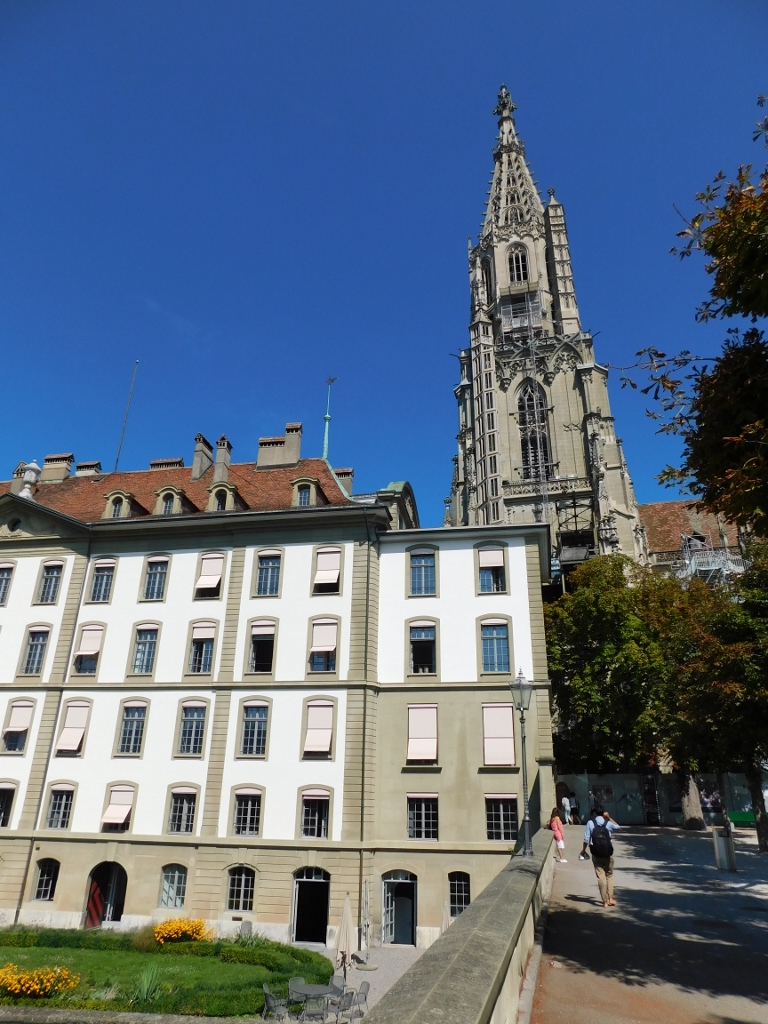 Part of the Terrace along the line of the tower of the Cathedral of Bern, a detail
Part of the Terrace along the line of the tower of the Cathedral of Bern, a detail
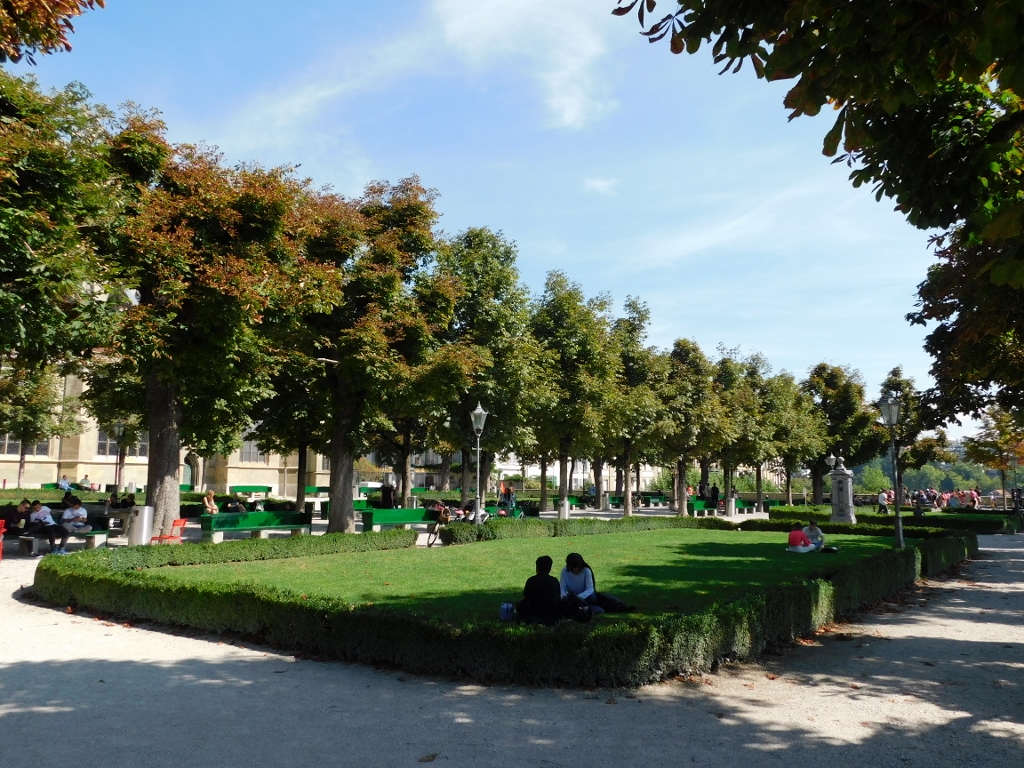 Park on the Minster Terrace
Park on the Minster Terrace
This area was envisaged around the middle of the 15th century as a churchyard, but over time there was also a graveyard here. During the 20th century the area was turned into a nice park. However, the main reason why you should come here is to enjoy the spectacular view at some parts of Bern and the Aare.

View from the Minster Terrace
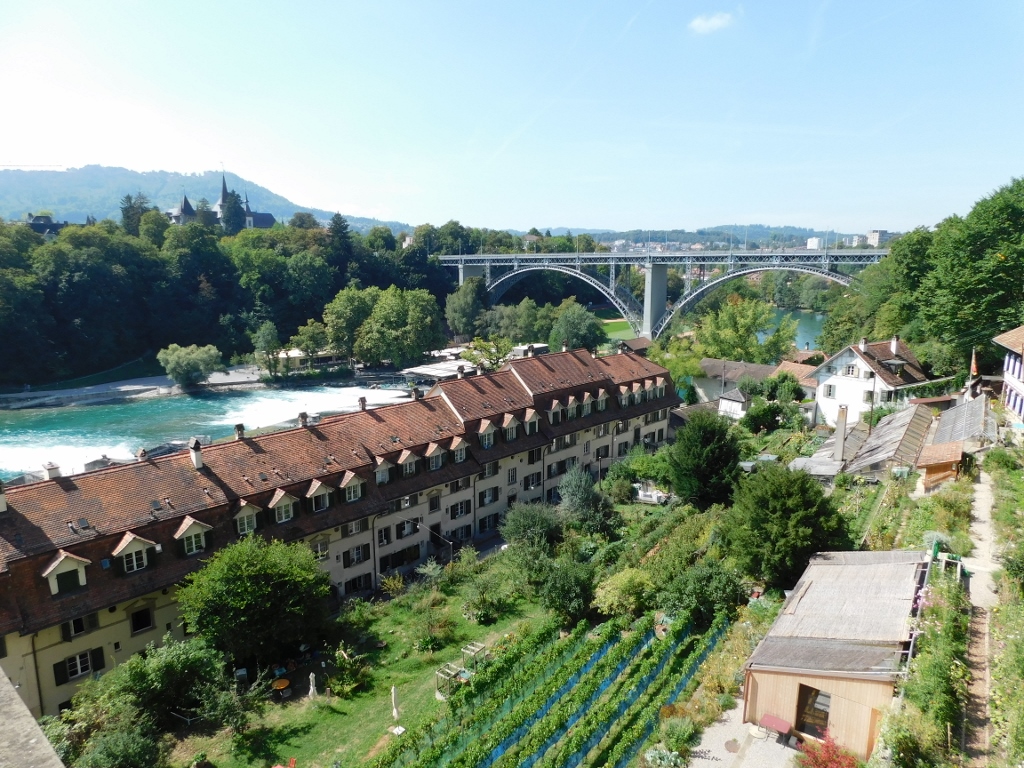 View from the Minster Terrace
View from the Minster Terrace
 View from the Minster Terrace
View from the Minster Terrace
 View from the Minster Terrace
View from the Minster Terrace
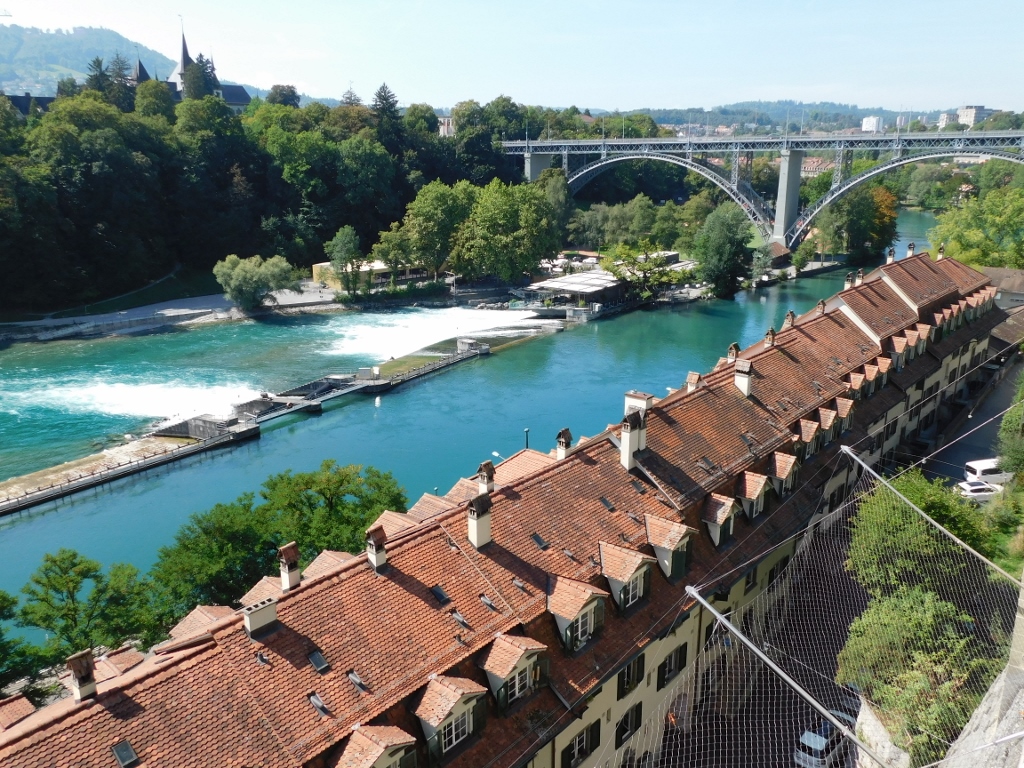 View from the Minster Terrace
View from the Minster Terrace
Here are these sights also in the form of a video:
Having enjoyed the wonderful views, I started to return slowly towards the streets of the city, but along the way I enjoyed some more in the lovely views around me.
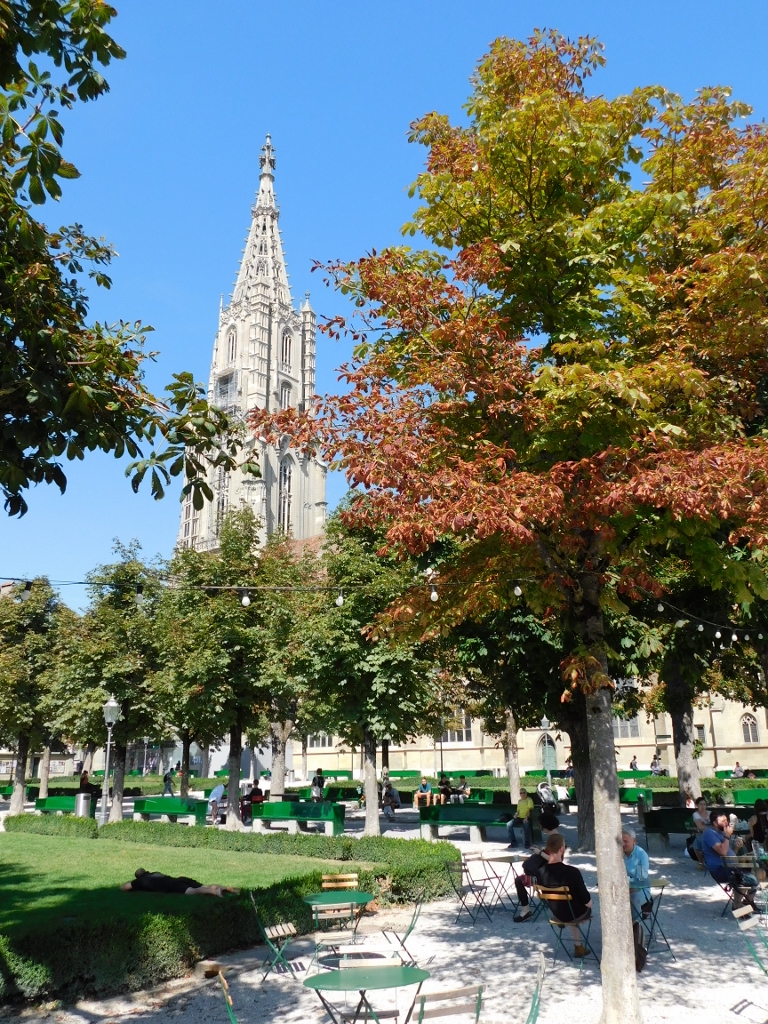 Park on the Minster Terrace and the Cathedral of Bern
Park on the Minster Terrace and the Cathedral of Bern
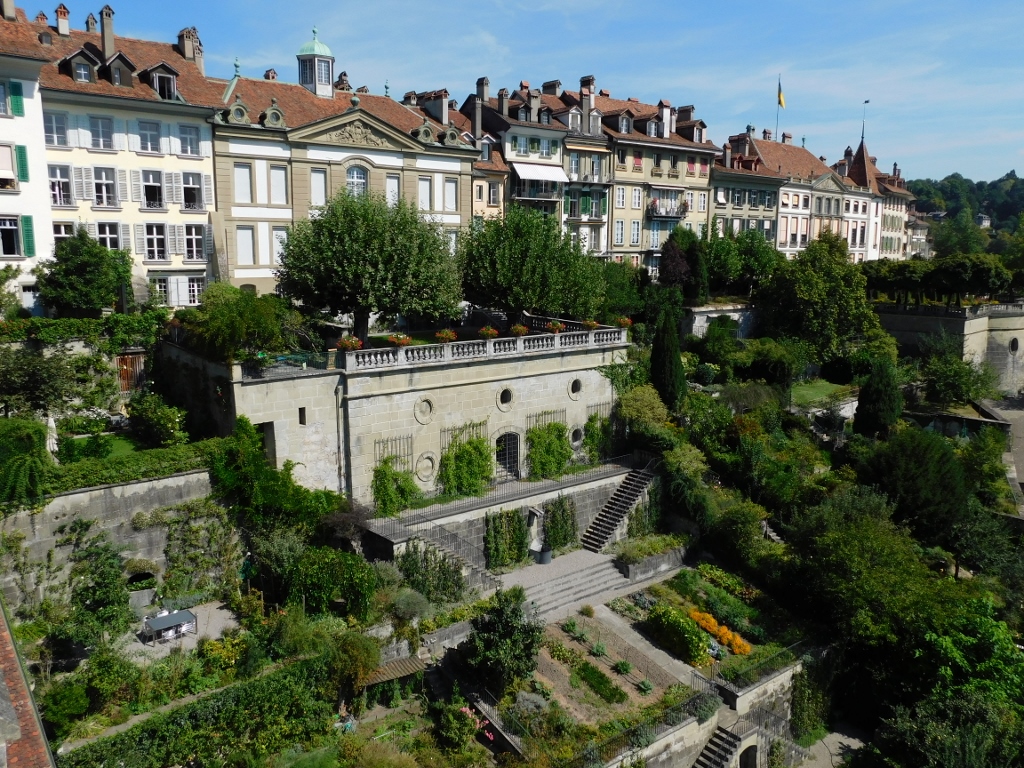 View at a part of Bern
View at a part of Bern